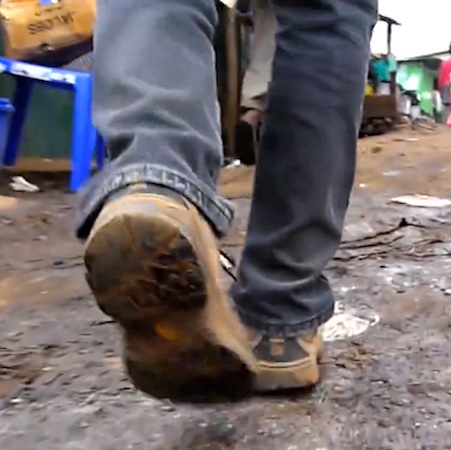
Slow journalism project merges ancient voyage with new media
Paul Salopek is about embark on a journey – a seven year, 39 country voyage to retrace the footsteps of ancient humans and chronicle it through new storytelling methods.
Salopek, a Pulitzer Prize winner and a National Geographic fellow, will walk the route from Africa to South America, collecting video, audio and narratives along the way. The Out of Eden Walk website, supported in part by Knight, will also experiment with tracking his journey using new digital mapping tools.
Tonight starting at 7 p.m. ET, tune in to hear Salopek share more about his journey via a livestream or follow along on Twitter with #edenwalk. Ann Marie Lipinksi, curator of the Nieman Foundation for Journalism at Harvard University, where Salopek researched his project as a visiting fellow last spring, will moderate the conversation. Knight recently asked Salopek more about his plan to merge new media technology and traditional storytelling and what he’s hoping to accomplish. How did you come up with idea for this journey? P.S.: I crossed my first border at age six when my parents moved to Mexico. So the questions raised by leaving home—identity, exile, the idea of the quest—interest me. I’m not alone. Everyone likes journey stories. They’re one of the oldest tropes around. Folklore. Mythology. A couple years ago, I was sitting in a cowboy bunkhouse in West Texas, thinking: What’s the most universal travelogue of all? I came up with the idea of human dispersal out of Africa. It’s a journey that belongs to everyone. What’s your goal? What would you like to accomplish? P.S.: This project is about narrative. We’re the storytelling species. In an age when information—the news cycle—has accelerated to a point of near-incoherence, this project aims to slow things down a bit by inching through current events at three miles an hour, using the panorama of deep history to find deeper meanings, broader contexts. Writing long. Writing episodically, not micro-blogging. It’s a quixotic ideal these days. The trend is the other way—towards relentless atomization, the nano-headline, the meme. The Out of Eden Walk will experiment with technology. But sometimes we forget that technology isn’t narrative. The walk is a nomadic laboratory for prolonging that gaze of attentiveness that comes with good storytelling. Your trip merges new media technology, journalism and storytelling. What are some of the experimental ways you plan to document it? P.S.: Apart from long-form writing, I’ll be taking narrative “core samples” along the way. At every 100 miles along the route, I’ll be recording a standardized set of multimedia recordings: 360-degree panoramas of the Earth’s surface, sonic ID’s of ambient sound, photos of the sky, of the ground, interviews with the person nearest each sampling point. Accreted over time and space, these shards will build a narrative mosaic or transect across the world—basically a cinematic tableaux of life at the turn of the millennium along the route of our ancestral migrations. I’m also working with brilliant partners such as National Geographic, Ethan Zuckerman at the MIT Civic Media Center and the Center for Geographic Analysis at Harvard to explore ways to map out and visualize social media conversations across the Earth—snapshots of the global conversation via Twitter and other social media along the route. I’m very lucky to have such hearts and brains “walking along” with me. You’re going to be covering a lot of ground. Any particular geographic areas or regions you’re most excited about visiting? P.S.: Too numerous to begin to list. The best travel involves surprise. So I’d venture that my favorite places will be ones I don’t know yet. Has your experience as a writer and a foreign correspondent helped you prepare? P.S.: It’s the best training I can think of. Good correspondents learn to spot the best story and it’s often not the one they were sent to cover. That’s going to be a major part of this experience: serendipity. Research is crucial, but not to the point of inducing tunnel vision. Being able to travel light, to sleep standing up, to go hungry, to pick up languages, to know when to wait and when to push—all this is important, too. Others have described the journey as a “return to classical experiential storytelling.” What does that mean? P.S.: When people tell me this journey is extreme, I remind them that it’s a return to the norm. We have collected and shared stories this way for 95 percent of humanity’s existence. Male hunter-gatherers walk on average nine miles a day. Women, who generally forage, walk six. We used to go out in the morning and circle back to the hearth and tell each other what we saw during the day. Jetting into stories from 30,000 feet or driving through them at 70 miles an hour—that’s extreme. So what I’m doing, walking to villages or towns, swapping tales, is in fact normal. The Greek bards shared their poems this way. The West African griots did it. It’s classical. How are you preparing, both physically and intellectually, for the trip? P.S.: I’m blessed to be in reasonable physical shape for my age. I can’t take the credit. It’s genetics. And I have been doing this sort of thing for 20 or more years already—immersive, physical journalism. I covered Africa for more than a decade and that involved a lot of muscular reporting in rural landscapes. So in a sense I’ve been preparing without knowing it. The same goes for the intellectual dimension. Seven years is a long time to be gone. Is there anything do you think you’ll miss from home? P.S.: I will miss many things, foremost my family and friends. I wouldn’t be able to do this if they weren’t offering to join me repeatedly en route, to meet me, to walk along.
By Elizabeth R. Miller, communications associate at Knight Foundation
Recent Content
-
Journalismarticle ·
-
Journalismarticle ·
-
Journalismarticle ·


